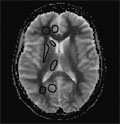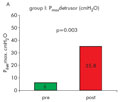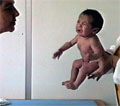The eLitMed.hu medical portal uses computer cookies for convenient operation. Detailed information can be found in the Cookie-policy.
Clinical Neuroscience - 2005;58(09-10)
Content
[Frontotemporal dementia - Part III - Clinical diagnosis and treatment]
[The authors report a comprehensive publication consisting of three parts going into the details of history, prevalence, clinical forms, differential diagnosis, genetics, molecular pathomechanism, and pathology, clinical diagnosis and treatment of frontotemporal dementia (FTD). The third part of the present review focuses on the clinical diagnosis and treatment of FTD. The diagnosis of FTD is problematic even today. Mental status, psychometric testing as well as imaging studies such as PET and SPECT, and laboratory examinations may be helpful in the diagnosis. Unfortunately, bedside tests are generally insensitive to mild dysexecutive deficits. Most of FTDs do not have characteristic laboratory abnormalities or brain atrophy sufficient to set up the diagnosis; these only allow to rule out other disorders and assume the diagnosis of FTD. An effective treatment for FTD is still to be established. The improvement of serotonin metabolism has been proposed as a biological treatment. Recent studies suggest that bromocriptine may improve selective frontal symptoms, but this and the efficacy of other dopaminergic drugs need further evaluation. Drugs that prevent the expression or accumulation of tau seem to be the most promising causal approach. In aphasia behavioral therapy may be attempted. In addition, caregiver management is essential, because as with those of Alzheimer’s dementia patients, they also carry a significant psychosocial stress.]
[Regulation of water transport in brain oedema]
[The study gives an overview on the regulation of cerebral water content and of brain volume. The molecular mechanisms of the development and resolution of various oedema forms are discussed in detail. The physiological and pathophysiological role of the recently discovered molecular water channel proteins aquaporin-1 (AQP1) and aquaporin-4 (AQP4) as well as the importance of central neuroendocrine regulation by vasopressin and atriopeptin are reviewed based on the relevant literature and personal studies. Quantitative water maps based on the combination of multicompartment- T2, diffusion weighted MRI and T1 studies have proven to be powerful tools for studying new drugs against brain oedema brought about by various neuropathological conditions and for testing their efficacy both in animal experimental and clinical conditions. Non-peptide vasopressin antagonists, atriopeptin agonists and drugs targeting AQP4 are potential new families of oedema-decreasing drugs.]
[Ischemic preconditioning in the brain]
[Stroke-related death is the third most common cause of mortality in Hungary after cardiovascular diseases and cancer. In addition to the unfavourable mortality figures, the consequent development of neurological and psychiatric disorders in stroke patients imposes an enormous burden on the health care system and on the families. Numerous studies are being conducted world wide on the prevention of stroke and other cerebrovascular disorders like chronic hypoperfusion, as well as on acute stroke management and patient rehabilitation issues. As a result, our understanding of the mechanism of hypoxic brain damage steadily increased over the past years and decades which brought along promising achievements both in the field of stroke prevention and therapy. However, these broad-spectrum approaches also made clear that preventing neuronal death and thus reducing neurological damage are complex tasks that cannot be successfully resolved by targeting single mechanisms. Therefore, the development of alternative new drugs and clinically applicable complex neuroprotective strategies is warranted. One of the most promising approaches is to create ischemic tolerance in the brain by using pharmacological preconditioning paradigms. These drugs trigger similar events to those initiated by brief ischemic insults that later can make the cerebral tissue resistant to subsequent otherwise lethal stress (ischemic preco]
[Evolutionary pressure in the development of the unconscious-conscious duality in young children]
[Evolutionary pressure in the development of the unconscious-conscious duality in young children 2005;58(09-10)]
[Bladder rehabilitation in neurogenic and non-neurogenic detrusor dysfunction with intravesical electrotherapy]
[Bladder rehabilitation in neurogenic and non-neurogenic detrusor dysfunction with intrave 2005;58(09-10)]
[Complex elementary movements of humans - The anthropological approach of Ferenc Katona]
[All species are an optimized product of evolution. For humans, realization and knowledge of the highly sensitive and sensible biocybernetic processes in our bodies is now largely out of sight in modern medicine. To develop an evolutionary and at the same time a crosscultural perspective of human life and its biological, psychological and social conditions is particularly important for the health sciences.]
[9th Hungarian Congress on Alzheimer’s disease]
[9th Hungarian Congress on Alzheimer’s disease 2005;58(09-10)]
1.
Clinical Neuroscience
[Headache registry in Szeged: Experiences regarding to migraine patients]2.
Clinical Neuroscience
[The new target population of stroke awareness campaign: Kindergarten students ]3.
Clinical Neuroscience
Is there any difference in mortality rates of atrial fibrillation detected before or after ischemic stroke?4.
Clinical Neuroscience
Factors influencing the level of stigma in Parkinson’s disease in western Turkey5.
Clinical Neuroscience
[The effects of demographic and clinical factors on the severity of poststroke aphasia]1.
2.
3.
4.
5.













